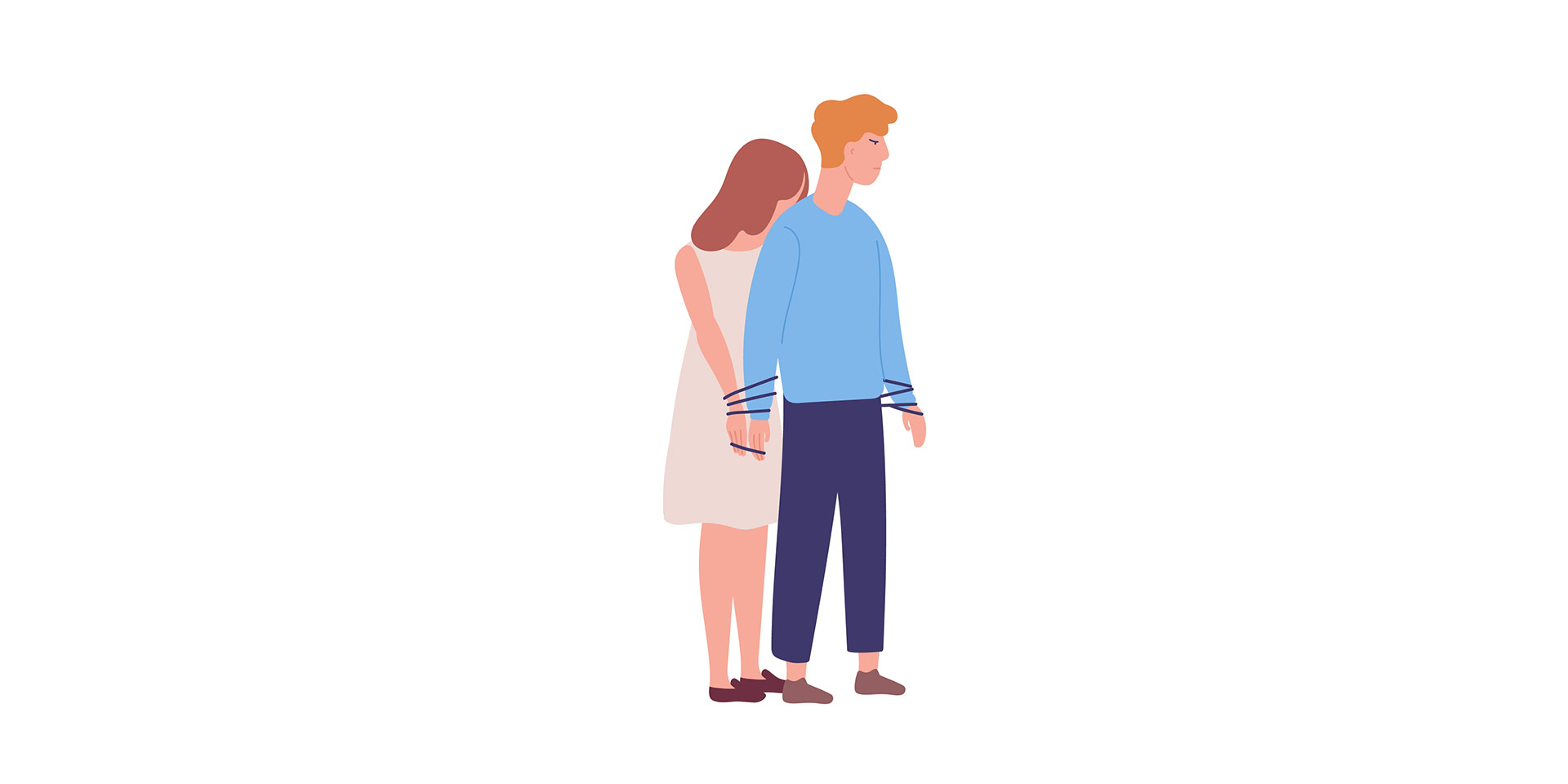A word is dead when it is said, some say. I say it just begins to live that day. – Emily Dickinson
The words we give life to shape our lives in ways that are not always obvious. We all want to hear “music to our ears” and we all know that “silence speaks volumes”, but the secret is not just in the obvious balance between the two. There are also “impostor” words, which present themselves as something other than what they are. “Codependency” seems to be one of them.
“Codependency” has become a fashionable term in self-help literature. Numerous titles dealing with the subject of codependency are being sold in their millions. The Maze of Codependency, and Getting Out of the Maze (both written by Frank Minirth, Robert Hemfelt and Paul Meier), Women Who Love Too Much (by Robin Norwood), Is It Love Or Is It Addiction? (by Brenda Schaeffer), “Love doesn’t hurt” (by Montse Barderi) and, last but not least, Perfect daughters: Adult Daughters of Alcoholics (by Robert Jackerman) are among the famous most recent volumes on this subject, all of them available in bookstores in Romania as well.
All these books have a common thread: those close to those who suffer from various addictions (alcohol, drugs, gambling, shopping, and so on) are tainted by an addiction as well—they are the captives of a self-destructive desire to save the addict. Because they love them, these people ignore their own needs and desires until they are completely oblivious to them, dealing exclusively with satisfying the needs and desires of their loved one. Through this sacrificial spirit, the codependent person is, in reality, encouraging the very behaviour they are trying to control and change in the other person. And this vicious circle ultimately destroys both people.
Full of disturbing life stories of people who once lived with an addict, these books advocate a therapeutic refocusing on the codependent person’s own needs. Unfortunately, popular sources of information about codependency provide confusing, sometimes even contradictory data, that typecasts their problems and proposes over-simplified solutions, instead of helping those that are most at risk of harm in a relationship with an addict.
What, in fact, is codependency?
In a study published in 1988, psychologists Asher and Brissett presented the results of their research into codependency. The study had involved them interviewing 52 women whose husbands had been diagnosed and treated for alcoholism. The authors said that, although women frequently identified as codependent, none of them explained the term using the same words as the others. The researchers noticed that some women said that codependency had profoundly changed their identity, while others said the opposite; some said that codependency was a disease, others that it is not; some said it was a personality trait, or a role learned from society; some said it was a permanent state, others that it was temporary. However, although they had contradictory definitions, they were all convinced that they were codependent.
The same confusion about the causes and symptoms of codependency is found in the specialized literature:
“Codependency is a recognisable pattern of personality traits, predictably found within most members of chemically dependent families, which are capable of creating sufficient dysfunction to warrant the diagnosis of mixed personality disorder, as outlined in DSM III. (Timmen Cermak)
“A codependent person is one who has let another person’s behaviour affect him or her, and who is obsessed with controlling that person’s behaviour.” (Melody Beattie)
“Codependency is defined as a primary condition that results from the debilitating physiological stress produced by living in a committed relationship with an alcoholic or drug-dependent person.” (W. Mendenhall)
“Codependency is… any suffering and/or dysfunction that is associated with or results from focusing on the needs and behaviour of others.” (Charles Whitfeld)
“A co-dependent is an individual who has been significantly affected in specific ways by current or past involvement in an alcoholic, chemically dependent or other long-term, highly stressful family environment.” (Ronald and Patricia Potter-Efron)
“Codependency is a primary disease and a disease within every member of an alcoholic family” (Wegscheider-Cruse, quoted by Anne Wilson Schaef)
Jennifer McGlone, the provider of these examples, pointed out in her doctoral dissertation that “the only two components that appear repeatedly [in otherwise divergent definitions] are: (1) notions of caretaking and responsibility for others and (2) affliction by association with chemically dependent individuals”.
This confusion is partly explained by the history of the term. How did “codependency” become such a widespread concept?
Popularisation of the concept of “codependency”
In 1784, in America, one of the signatories of the Declaration of Independence, Dr Benjamin Rush, was the first to describe alcoholism as a disease. The Victorian era erased this label, but it resurfaced in the 1930s and 40s, when once again, alcoholism stopped being seen as simply immoral behaviour, but as a manifestation of a disease. Alcoholics were once more seen as victims of biological and psychological processes that dictated their uncontrollable behaviour.
At the same time, the “family system” movement emerged, a branch of psychology that studies human behaviour and experience within the family, seen as a system. The new vision proposed the understanding of alcoholism in the family context in which it develops, as a reciprocity of forces: the behaviour of the alcoholic affects the entire family and the whole family contributes to the behaviour of the alcoholic. This also seemed to explain why children of alcoholics tend to become alcoholics themselves.
It was not until the 1970s that the term “codependency” began to appear in the literature, filling the previously vacant position of a word describing the uncontrollable, compulsive behaviour of family members of alcoholics. Before “codependent”, terms such as “co-alcoholic”, “para-alcoholic”, or “non-alcoholic” were used. But the “codependent” word won the battle of words because it was much more comprehensive.
 By the 1980s, the term had already gone beyond alcoholism and was being applied to all sorts of situations. Author Melody Beattie said that “as professionals began to understand codependency better, more groups of people appeared to have it: adult children of alcoholics, people in relationships with emotionally or mentally disturbed persons, people in relationships with chronically ill people, parents of children with behaviour problems, people in relationships with irresponsible people.”
By the 1980s, the term had already gone beyond alcoholism and was being applied to all sorts of situations. Author Melody Beattie said that “as professionals began to understand codependency better, more groups of people appeared to have it: adult children of alcoholics, people in relationships with emotionally or mentally disturbed persons, people in relationships with chronically ill people, parents of children with behaviour problems, people in relationships with irresponsible people.”
But the grounding of the term “codependency” was mainly a result of promoting the cultural arsenal of the “Alcoholics Anonymous” movement. The foundations of the description of “codependency” come from the experience of treating alcoholics, in which specialists noticed that an alcoholic’s wife tends to compensate for the shortcomings that her partner produces in family life. She does what he has to do around the house: she cleans, pays the bills, or covers for him so that the family won’t be embarrassed. This “help” provides the alcoholic with an existence sheltered from the consequences of his substance abuse. This led to the idea of ”facilitation”, more precisely to the situation in which, by shielding the alcoholic from consequences, the wife inadvertently encourages his behaviour. She becomes “codependent” in the sense that she is seen as a wheel in the supportive infrastructure of the alcoholic husband’s addiction.
There are some serious “buts”
Although the literature on codependency calls on people who are close to addicts to break the vicious circle of support—thus contributing to alleviating the sense of guilt that often accompanies the addict’s partner’s natural desire of not responding as a slave to their needs and desires—a few warning signals are necessary.
First, the easy use of “codependence” as a diagnosis carries the disadvantage of possibly becoming a self-fulfilling prophecy or worse; it can be a simple label applied as a substitute for thorough analysis. Some specialists warn that the current tendency, visible in the popular psychology literature, to see some personality traits or some character phenomena as addictions, and addiction as a disease, is not okay.
It is true that the literature on codependency contains some insightful information that is in line with current trends in psychoanalysis, emphasising the importance of interpersonal relationships. American teacher Janice Hoaken has said that the “codependency literature expresses the pain, anguish, and helplessness, combined with an overwhelming, wearisome responsibility for others that dominates the lives of many women.” There are women who are trying desperately to hold families together and to keep things going under seemingly impossible conditions. This literature speaks of the emotional deprivations of women, particularly in their relationship with men, and of the experience of “finding gratification and a sense of strength through… ’emotional work’ i.e., managing the feelings of others.” But no researcher has been able to unequivocally demonstrate that codependency is more common among the family of an addict.
Various correlations between codependency and alcoholism have been made, but those who have analysed all the research in the field have noticed that these correlations occur against very complex backgrounds, and in family environments where emotional or physical abuse or other dysfunctional aspects play a role. On the other hand, much research has been able to demonstrate other possible reasons for developing and maintaining codependency: childhood abuse, an authoritarian parenting style of the father, a dysfunctional educational style, a violent family atmosphere, lack of acceptance, lack of communication, lack of family satisfaction and support, as well as a high level of control or family “ties”.
About codependency, in terms of development
Research into the neurobiology of human development and attachment has shown that dependence on others occurs when a person has not had a good relationship (in which to feel safe) with people who were meant to care for them, and develops self-protection strategies that they continue to use in adult relationships, although they are no longer needed.
Codependency could therefore be not a disease, but a matter of development. It is a habit we formed when we needed it the most, but which is no longer appropriate for the present. From this perspective, psychologist Anne Dranitsaris says it would be more beneficial to look at codependency as proof that we are built with a self-protective system. “Let’s celebrate,” she said, “rather than believing we are ill.”
Illness involves the premise of helplessness, says Dranitsaris, and this prevents people from developing a healthy sense of their own power and authority in relationships. “It does nothing for brain development [on the AA model] as people are encouraged to identify themselves as codependent. ‘Hi, my name is Anne and I’m a co-dependent.'”
A person who wants to help others out of love may face justified dilemmas about how much they are willing to sacrifice for the good of the other. The tendency to blame such a person fits with the increasingly individualistic view present in developed societies (from which we get a large part of our information). But it cannot be an effective way to bring about healthy change, even if the person really suffers from an extreme and self-destructive form of codependency.
It is true that when we engage in self-protective behaviours for a long time, they become complex and intertwined with our automatic emotional responses, such as fear, anxiety, hatred, pain, guilt, and personal depreciation. But the key to change, which psychologists say is possible over time, is not overcoming codependency by reading a book that will bring you to your senses. The key lies in the long-term journey of undertaking the process of growth and development once again, from the place where it has been interrupted.
Alina Kartman is a senior editor at ST Network and Semnele timpului.



















